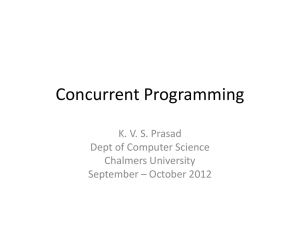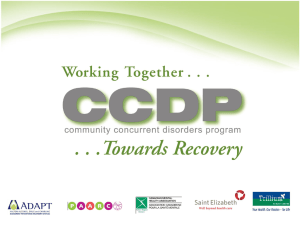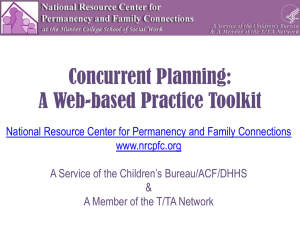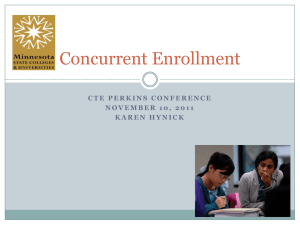PowerPoint - Harvard Law School
advertisement
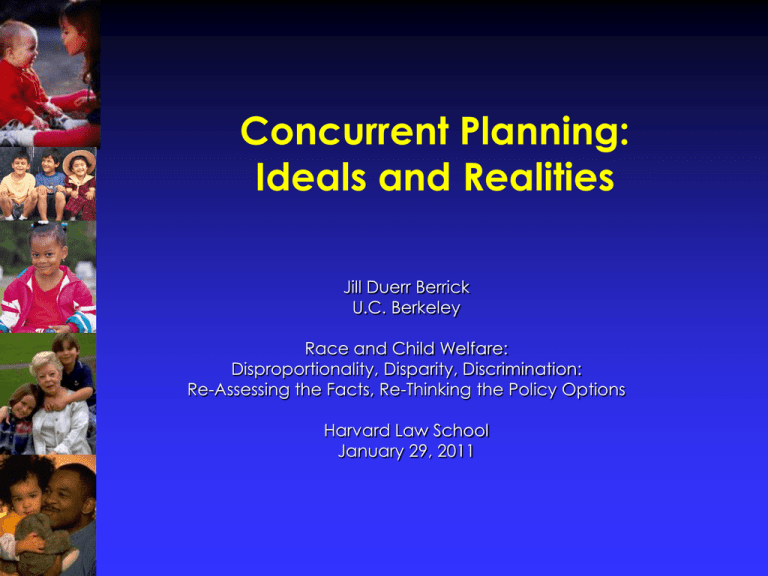
Concurrent Planning: Ideals and Realities Jill Duerr Berrick U.C. Berkeley Race and Child Welfare: Disproportionality, Disparity, Discrimination: Re-Assessing the Facts, Re-Thinking the Policy Options Harvard Law School January 29, 2011 Concurrent Planning: What is it? Reasonable efforts toward an alternative permanent placement, should reunification fail. Elements include: • Development of a concurrent plan; • Reunification prognosis; • Full disclosure • Discussion of voluntary relinquishment • Fost-adopt placement (D’Andrade, 2009) Concurrent Planning: What is the Legal Framework? Adoption and Safe Families Act (1997) Clarifies that reasonable efforts may be made concurrently Concurrent Planning: Who Does it? 51 of 52 CFSR state reports mention Concurrent Planning (Children’s Bureau, 2004) 87% of local public child welfare agency administrators indicate implementing concurrent planning (Mitchell, et al., 2005) At least 36 states have formal policies 4 states require it (Gerstenzang & Freundlich, 2005) Theoretical Benefits of Concurrent Planning 1. Reduced length of stay in care 2. Increased likelihood of permanency, including reunification 3. Increased placement stability 4. Increased opportunity for stable attachment relationships. 5. Increased opportunity for positive and ongoing relationships between birth and foster parents Findings from Concurrent Planning Studies Pre-experimental studies show positive effects on permanency (Katz, 1990) Non-experimental comparison group studies show positive effects on placement stability and time-toadoption (Brennan et al., 2003; Cooperative Ventures, n.d.; Martin, et al., 2002; Monck, Reynolds, & Wigfall, 2003; Schene, 1998) Single-group correlational studies show positive effects on timely permanency (Potter & Klein-Rothschild, 2001) Findings (con’t) CA Observational study (n=885) • Concurrent Planning not associated with overall permanency. • Full Disclosure associated with a lowered likelihood of reunification • Discussion of voluntary relinquishment associated with increased likelihood of adoption (D’Andrade, 2009) Is Concurrent Planning Really Happening? “Concurrent planning efforts are not being implemented on a consistent basis when appropriate” (Children’s Bureau, 2004) A Look at Concurrent Planning Activities in California Reunification prognosis 29% Concurrent Plan identified (at Dispo) 55% Concurrent Plan identiied (later court hearing) 42% 2 social workers 18% SW explored permanency with FP 29% SW searched for alternative perm plan 32% Child in fost-adopt home 6% Voluntary relinquishment discussed 23% Full disclosure 54% (D’Andrade, Frame, & Berrick, 2006) A Look at Concurrent Planning Guidelines in New York State Five Core Elements of practice: • Differential assessment to determine likelihood of reunification • Open, honest dialogue between caseworker, parents, and foster parents • Good family assessments and constant evaluation of progress towards reunification • Extra emphasis on visiting • Early seeking out and assessment of relatives for possible placement, or alternatively, early determination that a relative would be an inappropriate placement for the child. (Gerstenzang & Freundlich, 2005) Concurrent Planning is Hard to Pull Off • Concurrent Planning is: • • • Resource intensive for agencies Emotionally-intensive for foster parents and birth parents Inappropriate for the majority of children entering care as they are likely to reunify Evidence-Informed Poor Prognosis Indicators • • • • • • • • • • Younger child Behavior problems Child health problems Child of color Limited or no visiting Multiple placements in care Prior removals Neglect or emotional abuse Parent “emotional problems” Parent commission of a criminal offense • Parental housing problems • Parental substance abuse Are Some Expedited Permanency Decisions More Clear? • Reunification Bypass provisions • Murder of another child • Voluntary manslaughter • Aided, conspired etc. to commit murder; • Felony assault resulting in injury to child • Parental rights terminated for a sibling From Concurrent Planning Promise to Concurrent Practice What will it Take to Implement Concurrent Planning? 1. A pro-concurrent planning philosophy permeating the agency – including an understanding that concurrent planning may result in increased reunification What will it Take to Implement Concurrent Planning? 2. The availability of necessary services for birth parents What will it Take to Implement Concurrent Planning? 3. The presence of formal systems to insure concurrent planning occurs procedures for resolution of paternity issues early on Family Finding to identify kinship supports documentation of reunification prognosis and concurrent plan time-sensitive systems to track cases procedures for referral to a concurrent planning track, regularly scheduled review meetings related to the concurrent plan What will it Take to Implement Concurrent Planning? 4. The ability of child welfare staff to actively embrace concurrent planning – Including formal and informal training A collaborative approach to casework and case decision-making Integration or communication between child welfare and adoption units and/or agencies What will it Take to Implement Concurrent Planning? 5. The availability of an adequate pool of concurrent planning caregivers What will it Take to Implement Concurrent Planning? 6. The active promotion of concurrent planning in court. (Berrick, Frame, & Coakley, 2006) References Berrick, J.D., Choi, Y., D’Andrade, A., & Frame, L. (2008). Reasonable efforts? Implementation of the reunification exception provisions of ASFA. Child Welfare, 87(3). Berrick, J.D., Frame, L., & Coakley, J.F. (2006). Essential elements of implementing a system of concurrent planning. Child and Family Social Work, 11(4). Brennan, K., Szolnocki, J., & Horn, M. (2003). Lutheran Community Services concurrent planning evaluation Stuart Foundation final report. Seattle, WA. University of Washington, School of Social Work, N9rthwest Institute for Children and Families. Child Welfare Information Gateway (2005). Concurrent planning: What the evidence shows. Washington, D.C.: U.S. Department of Health and Human Services. Retrieved from: http://www.childwelfare.gov/pubs/issue_briefs/concurrent_evidence/index.cfm Children’s Bureau. (2004). General findings from the Federal Child and Family Services Review. Washington, D.C.: U.S. Department of health and Human Services, Administration for Children and Families. Retrieved from http://www.acf.hhs.gov/programs/cb/cwmonitoring/results/genfindings04/intro.htm Cooperative Ventures (n.d.). Concurrent permanency planning: Department of Human Services report of evaluation. Report for the Minnesota Department of Human Services. St Paul, MN: Author. D’Andrade, A. (2009). The differential effects of concurrent planning practice elements on reunification and adoption. Research on Social Work Practice, 19(4), 446-459. D’Andrade, A., & Berrick, J.D. (2006). When policy meets practice: The untested effects of permanency reforms in child welfare. Journal of Sociology and Social Welfare, 33(1). D’Andrade, A., Frame, L., & Berrick, J.D. (2006). Concurrent planning in public child welfare agencies: Oxymoron or work in progress? Children and Youth Services Review, 28(1), 78-95. References (con’t) Gerstenzang, S., & Freundlich, M. (2005). A critical assessment of concurrent planning in New York State. Adoption Quarterly, 8(4). Katz,, L. (1990). Effective permanency planning for chldren in foster care. Social Work, 35, 220-226. Martin, M.H., Barbee, A.P., Antle, B.F., & Sar, B./ (2002). Expedited permanency planning: Evaluation of the Kentucky Adoptions Opportunities Project. Child Welfare, 81(2). Mitchell, L.B., Barth, R.P., Green, R., Wall, A., Biemer, P., Berrick, J., Bruce Webb, M., and the National Survey of Child and Adolescent Well-Being Research Group (2005). Child Welfare Reform in the United States: Findings from a local agency survey. Child Welfare, 83(1). Monck, E., Reynolds, J., & Wigfall, V. (2003). The role of concurrent planning: Making permanent placements for young children. British Association for Adoption and Fostering, London. Potter, C.C., & klein-Rothschild, S. (2001). Getting home on time: predicting timely permanence for young children. Child Welfare, 81(2), 123-150. Schene, P. (1998). Expedited permanency planning in Colorado: An evaluation prepared for the Colorado Department of Human Services. Available from the Colorado Department of Human Services, Office of Children, Youth and Families, Denver, CO.
